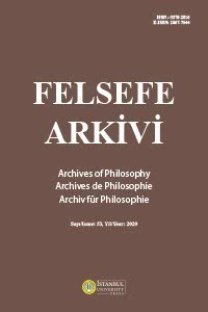Fenomenolojik Öznelerarasılığın Tersyüz Edilişi Olarak Komedi
Komedideki
‘komik özne’ ile canlandırdığı karakter arasındaki ayrımı, aktörün karakteri
sahneye koyma tarzından ziyade, karakteri nasıl alımladığı üzerinden
sorguladığımız çalışmada, komedideki öznelerarasılığı, Husserlci
fenomenolojiyle okumak, şüphesiz yüzü gülümseten tahlillere yol açmıştır. Nasıl
oluyor da başkası kılığında bir ben, kendi kumaşında olmayanın kılığına
girebiliyor? Nasıl oluyor da ‘başkasının beni’nden kendime aktardığım anlamla
kurduğum ‘öz-ben’im, başkasına dönüşmeden başkasıyla kalabiliyor? Yukarıdaki
sorularının yanıtlarının verilmeye çalışıldığı bu çalışmada, “öznelerarasılık”
sorununun temelindeki ‘ben-öteki’ ikiliği, komedi ile fenomenolojiyi, dikkate
değer ufuklarda buluşturmaktadır. ‘Öznelerarasılık’ temelinde buluşan, fakat
‘ben-öteki’ yarılmasını farklı yorumlarla açımlayan bu iki gelenek, bizi bir
yanıyla psikanalize, bir yanıyla Antikite’ye, bir yanıyla tiyatroya ve bir
diğer yanıyla fenomenolojiye bağlayan önemli bir kavramla hesaplaşmak zorunda
bırakmıştır: İmge. Böylece imge ve imgeden başka; temsil, gösterge, işaret,
yansıma, kopya, görünüş, fenomen, tekrar vb. kavramların aydınlatılarak
‘öznelerarasılık’ probleminin ele alındığı çalışmamızda, komedi ile
fenomenolojinin “başkası kılığında bir ben” ve “başka-ben’ler arasındaki
‘öteki’ olarak ‘ben’” olguları, birbirine düğümlenmek suretiyle
bağlantılandırılmıştır.
Comedy As The Invertion of The Phenomenological Intersubjektivity
In
this study, which we question the distinction between the comedy subject and
the actor’s portray of the character in the comedy as how the actor percieve
the character rather than his way of acting it out, reading the
intersubjectivity in the comedy with Husserl’s phenomenology causes rather
amusing analysis without a doubt. How come an ‘I’ in someone else’s image
masquerades as the one who is not a self-like? Howe come why ‘self essence’
that I created by transferring sense from ‘someone else’s I’ stays with someone
else without changeging into somebody else? In this study the the answers fort
he questions mentioned above try to be given, “the other-me” duality which lays
in the core of the ‘intersubjectivity’ problem, combines comedy and
phenomenology in bodacious scopes. This two traditions that explain ‘the-other
I’ sever in different interpretations but come to agree in intersubjectivity’s
core, obliged us to reckon with an important concept which links us with
psychoanalysis, antiquity, theatre and phenomenology on different parts: Image.
So, in our study which dealt with the ‘intersubjectivity’ problem by clarifying
image and other concepts like; representation, indicator, sign, reflection,
replica, aspect, phenomenon e.t.c. facts of comedy and phenomenology like “I
disguise as somebody else” and “as the ‘other me’ in between ‘other-selves’”,
connected by sealing.
Keywords:
Phenomenologic intersubjectivity, comedy, image, representation, indicator, aspect, reflection,
___
- .
- ISSN: 0378-2816
- Başlangıç: 1945
- Yayıncı: İstanbul Üniversitesi
Sayıdaki Diğer Makaleler
Abdurrazzak GÜLTEKİN, M. Cüneyt KAYA
Scientific Methodologies In Medieval Islam
Hegel’in Fenomenolojisi Bağlamında Özbilincin Diyalektiği
Ludwıg Wittgenstein’da Ahlaki Söylemin İmkanı
Fenomenolojik Öznelerarasılığın Tersyüz Edilişi Olarak Komedi
Platon’un Devlet Diyaloğu Bağlamında Eğitim Anlayışı
